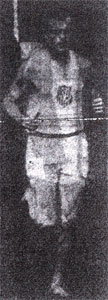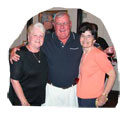Derby History Quiz
Current
Quiz Archives of all quizzes

Jimmy Keefe

|
 Jimmy
Keefe didn't make the Olympics, but had it not been for an injury
that short circuited him at his peak, he might have. He is
probably the greatest runner that Derby High School has produced to
date. He
capped his career in 1963 when as a Central Connecticut State
College student, he was a member of the United States Track & Field
team that competed and won duel meets in Russia, Poland, West
Germany and England. He was already the New England, NAIA and NCAA
College Division three mile champion when he made the team a year
before the Tokyo Olympics. Jimmy
Keefe didn't make the Olympics, but had it not been for an injury
that short circuited him at his peak, he might have. He is
probably the greatest runner that Derby High School has produced to
date. He
capped his career in 1963 when as a Central Connecticut State
College student, he was a member of the United States Track & Field
team that competed and won duel meets in Russia, Poland, West
Germany and England. He was already the New England, NAIA and NCAA
College Division three mile champion when he made the team a year
before the Tokyo Olympics.
Though he did not win on the tour, he was the top
American finisher in the 5,000 meter run in Moscow and in Warsaw. In
Hanover, he switched to the 10,000 meter run for the first time in
his career and was again the top American finisher while finishing
second to the German runner who overtook him in the last 100 yards.
In London, he was again the top American finisher in the 5,000 meter
run. The tour stamped him as one of the early favorites to make the
U.S. Olympic team in either the 5,000 or 10,000 meter for the 1964
Olympics.
Unfortunately, he struggled in 1964 and fell a bit short,
but he still ranks as the most accomplished runner to ever come out
of Derby High School. In responding to the quiz, Dave Petz of Texas
recounts, "Jimmy Keefe had a sitting heart rate of 42 bpm. His
endurance was almost super human- swam the race from the Rec Camp to
Indian Wells, got out of the water and started looking for something
to eat. Jimmy broke mostly all of the records held by Jim Foley,
circa DHS 1934."
 Jimmy
still returns to his home town occasionally, and you can see him
pictured on the right at the 2003 All Class Reunion. Jimmy
still returns to his home town occasionally, and you can see him
pictured on the right at the 2003 All Class Reunion. |
Correct answers were received
from: John M. Rak, Millie from Ansonia, Pastor Walt Mayhew, Rick Dunne, Tony
Cannici, Jack Skelding, Ann
Searles, Neil V. Dorso, Jack O'Callaghan, Eileen Petz Kirkner, Dave Petz,
To see our other earlier quizzes and learn more about Derby's unique
history, click here.

|

 Jimmy
Keefe didn't make the Olympics, but had it not been for an injury
that short circuited him at his peak, he might have. He is
probably the greatest runner that Derby High School has produced to
date. He
capped his career in 1963 when as a Central Connecticut State
College student, he was a member of the United States Track & Field
team that competed and won duel meets in Russia, Poland, West
Germany and England. He was already the New England, NAIA and NCAA
College Division three mile champion when he made the team a year
before the Tokyo Olympics.
Jimmy
Keefe didn't make the Olympics, but had it not been for an injury
that short circuited him at his peak, he might have. He is
probably the greatest runner that Derby High School has produced to
date. He
capped his career in 1963 when as a Central Connecticut State
College student, he was a member of the United States Track & Field
team that competed and won duel meets in Russia, Poland, West
Germany and England. He was already the New England, NAIA and NCAA
College Division three mile champion when he made the team a year
before the Tokyo Olympics.  Jimmy
still returns to his home town occasionally, and you can see him
pictured on the right at the 2003 All Class Reunion.
Jimmy
still returns to his home town occasionally, and you can see him
pictured on the right at the 2003 All Class Reunion.